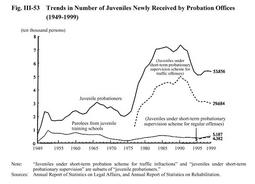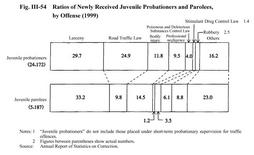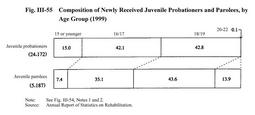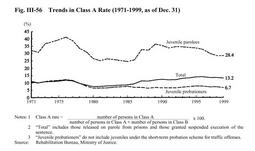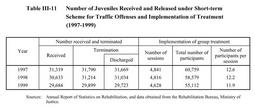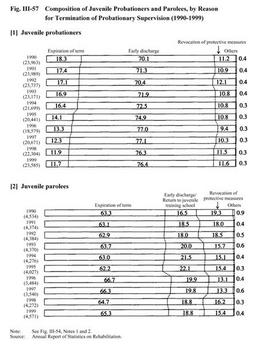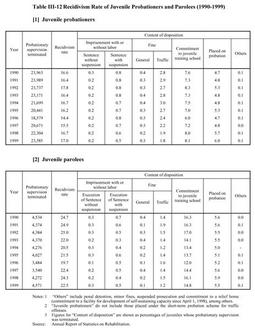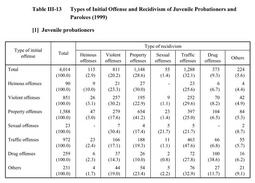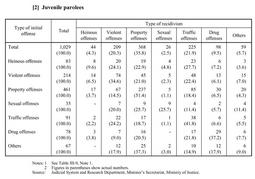| Previous Next Index Image Index Year Selection | |
|
|
2 Probationary supervision of juveniles This section covers probationary supervision of juvenile probationers and parolees from juvenile training schools.
(1)Trends in probationary supervision cases Fig. III-53 shows the number of juvenile probationers and parolees from juvenile training schools newly received by probation offices since 1949(see Appendix II-12 ). The number of juvenile probationers newly received by probation offices increased drastically from1977,when the short-term probationary supervision scheme for traffic offenses was introduced. The number remained at around70,000from1983but started to decrease in1991. Although it turned up in1996as the scheme for short-term probationary supervision scheme for regular offences was introduced in September1994,the number declined by356(07. %)from the previous year to53,856in1999(see(4)below). Fig. III-53 Trends in Number of Juveniles Newly Received by Probation Offices(1949-1999) Parolees from juvenile training schools also increased from1977,partly due to the introduction of short-term treatment in juvenile training schools, but continued a downward trend from the late1980s. It turned up, however, in1997and reached5,187in1999,up372(7.7%)from the previous year.In addition to juvenile probationers and parolees from juvenile training schools, juvenile parolees from prisons and juveniles granted suspension of execution of the sentence are also placed under probationary supervision. The number newly received in1999was1(no change from the previous year)for the former and28(down from30)for the latter. (2)Characteristics of juveniles under probationary supervision a. Categories of offense Fig. III-54 shows the ratios of juvenile probationers(excluding those placed under short-term probationary supervision for traffic infractions;the same applies throughout in this segment)and parolees from juvenile training schools newly received by probation offices in1999,by offense. The ratio of Road Traffic Law violations was high among juvenile probationers, whereas the ratios of larceny and bodily injury were largest among juvenile parolees. Fig. III-54 Ratios of Newly Received Juvenile Probationers and Parolees,by Offense(1999) b. AgeFig. III-55 shows the composition of newly received juvenile probationers and parolees in1999,by age group.16/17-year-olds and18/19-year-olds had the largest shares in juvenile probationers. Although18/19-year-olds also had the largest share in juvenile parolees,13.9%of them were released on parole from juvenile training school after reaching the age of20. Fig. III-55 Composition of Newly Received Juvenile Probationers and Parolees, by Age Group(1999) Table III-9 Composition of Juvenile Probationers and Parolees, by Age Group and Type of Offense(1999) The relationship between types of offense and age groups is shown in Table III-9. 16/17-year-olds had the largest share in juvenile probationers for heinous, violent and property offenses, while the ratio of18/19-year-olds was highest for sexual, traffic and drug offenses. Almost one in four juvenile probationers for property offenses as well as one in five for heinous and violent offenses were15years of age or younger, pointing to a higher percentage of younger age groups in juvenile probationers than in juvenile parolees. As regards juvenile parolees,18/19-year-olds had the largest share for all types of offense other than property offenses, for which16/17-year-olds had the highest ratio. Nonetheless,28.6%of drug offenders and21.5%of sexual offenders were over20years of age.c. Nationality By nationality(including regions), the Japanese had the highest share in juvenile probationers newly received in1999with98.4%, followed by Koreans with0.9%, Brazilians with0.4%, Chinese with0.1%, and others with0.2%. As regards juvenile parolees, the Japanese also had the largest share by far with97.8%, followed by Koreans with1.3%, Brazilians with0.4%, Chinese with0.2%, Philippine nationals, Vietnamese and Peruvians with0.1%each, and others with0.1%. The nationalities of juvenile parolees were more diversified than in1998(source:Annual Report of Statistics on Rehabilitation). d. Previous record of protective measures By previous record of protective measures, the ratio of juveniles with no previous record was highest in juvenile probationers newly received in1999with48.2%. This was followed by those who had been placed under probationary supervision with18.9%, those who had been dismissed after a hearing with16.2%, and those who had been dismissed without a hearing with14.0%. Among juvenile parolees, those without any previous record only accounted for26.5%. As regards parolees with previous records, former probationers had the largest share with39.6%, followed by those who had been committed to juvenile training schools with16.3%, those who had been dismissed after a hearing with7.7%, and those who had been dismissed without a hearing with5.8%. The ratio of those without previous record had been rising for both juvenile probationers and parolees, but declined in1999in both cases(source:Annual Report of Statistics on Rehabilitation). e. Drug use Among juvenile probationers newly received in1999,16.2%were using drugs at the time of reception. Organic solvents were used most frequently(13.7%), followed by stimulant drugs with1.9%. As regards juvenile parolees,39.8%were using drugs at the time of reception, more than double the ratio for juvenile probationers. By type of drug, organic solvents(28.4%)and stimulant drugs(10.5%)were used most commonly. In particular, the ratio of stimulant drug users was more than five times as large as in the case of juvenile probationers(source:Annual Report of Statistics on Rehabilitation). f. Relationship with delinquent groups 36.6%of juvenile probationers newly received in1999had relationships with delinquent groups. Hot-rodders were the most frequent group of association(17.3%), followed by local delinquent groups(12.9%)and delinquent pupil/student groups(4.9%). The percentage was as high as61.8%for juvenile parolees, with frequent association with hot-rodders(33.1%), local delinquent groups(20.7%)and organized crime groups(4.4%), in that order. The percentage of relationship with organized crime groups was more than seven times as high as for juvenile probationers(0.6%)(source:Annual Report of Statistics on Rehabilitation). g. Others Other characteristics of juvenile probationers and parolees newly received in1999are as follows(source:Annual Report of Statistics on Rehabilitation). 1)Concerning the living standard of guardians,89.3%of them were"ordinary",8.5%were"poor"and2.1%were"rich"in the case of juvenile probationers. For juvenile parolees, the ratios were85.2%,13.2%and1.3%, respectively. 2)As regards living circumstances,93.6%of juvenile probationers lived with their family(60.6%with both parents,21.0%with the mother and7.1%with the father, in that order). Only3.8%lived on their own.95.2%of juvenile parolees lived with their family(55.3%with both parents,24.9%with the mother and9.6%with the father).3.0%lived in halfway houses. 3)By employment situation,46.7%of juvenile probationers were employed, followed by pupils/students with27.1%and the unemployed with25.2%. As for juvenile parolees, the unemployed had the largest share with66.5%, followed by the employed with26.4%and pupils/students with5.9%. 4)By educational level,36.6%of juvenile probationers were senior high school dropouts,25.0%were junior high school graduates,18.0%were senior high school students,12.1%were senior high school graduates or above and7.7%were junior high school pupils or lower, in that order. As for juvenile parolees, the largest share belonged to junior high school graduates with50.3%, followed by senior high school dropouts with39.6%and senior high school students with3.5%. Senior high school graduates or higher and junior high school pupils or lower had insignificant shares. (3)State of treatment in probationary supervision a. Measures for juveniles with good record The following measures(alleviation measures)are taken for juveniles whose behavior has been so stabilized in the course of probationary supervision that the resumption of delinquency is deemed unlikely. [1]Juvenile probationers: Early discharge from probationary supervision, and temporary suspension of probationary supervision. [2]Juvenile parolees: Early discharge from probationary supervision. In 1999,the measure of early discharge was taken for47,794juvenile probationers(down from48,057in the previous year), of whom juvenile probationers under the short-term scheme for traffic offences accounted for29,723(down from31,034). Temporary suspension for juvenile probationers and discharge for juvenile parolees were applied to100(down from204)and863(up from786)persons, respectively(source:Annual Report of Statistics on Rehabilitation, etc. ). b. Measures for juveniles with bad record The following measures(aggravation measures)are taken against juveniles who have violated the conditions of release or committed repeat delinquency, etc. , in the course of probationary supervision. [1]Juvenile probationers: Notification to family court demanding new disposition. [2]Juvenile parolees: Return to juvenile training school. In1999,notification was made for36juvenile probationers(up from33in the previous year)while11juvenile parolees were returned to juvenile training school(up from7)(source:Annual Report of Statistics in Rehabilitation, etc. ). (4)Various schemes a. Classified treatment scheme Fig. III-56 shows the Class A rate since 1971,when the classified treatment scheme started(see Part2, Subsection 5-3-3(1) ). The Class A rate for juvenile parolees is traditionally high, largely staying in the30%range since 1987. However, it has been in a downward trend in recent years. Fig. III-56 Trends in Class A Rate(1971-1999,as of Dec.31) b. Categorized treatment schemeTable III-10 shows the ratios of juvenile probationers and parolees belonging to major categories in the categorized treatment scheme as of December31,1999(see Part 2, Subsection 5-3-3(2) ). Table III-10 Ratios of Juvenile Probationers and Parolees by Category (as of Dec.31, 1999) c. Short-term probationary supervision for juvenile traffic offendersThe short-term probation scheme for traffic offenses provides for group treatment concerning careful driving, etc. , for juveniles whose tendency toward traffic delinquency has not been established. It also requires individual juveniles to report periodically on their living conditions. They will be discharged from probationary supervision after a short period-three or four months, in principle-unless any offense is repeated while driving vehicles. Table III-11 shows the number of juveniles received and released under the short-term scheme for traffic offenses as well as the implementation of group treatment in the last three years. Table III-11 Number of Juveniles Received and Released under Short-term Scheme for Traffic Offenses and Implementation of Treatment(1997-1999) d. Short-term probationary supervision for regular offensesOf the juveniles placed under probationary supervision for offenses other than traffic professional negligence and road traffic violations, short-term probationary supervision for regular offenses covers those who have not markedly developed delinquent tendencies and for whom improvement and rehabilitation may be expected after a short period of probationary supervision. Implemented in approximately six or seven months, the scheme selects particularly important guidance areas for the rehabilitation of individual areas, wherein to conduct intensive treatment focused on certain assignments corresponding to such guidance areas. The scheme also requires juveniles to submit periodical reports on their living conditions. 4,382juveniles(18.2%of juvenile probationers except those placed under the short-term probation scheme for traffic offenses)were received under this scheme in1999(source:Annual Report of Statistics on Rehabilitation). e. Social participation activities Social participation activities mainly involve the participation of juveniles under probationary supervision in volunteer work, such as assisting in nursing care in homes for the aged and cleaning activities in parks. They are implemented as part of the assignments not only for juveniles placed under short-term probationary supervision for regular offenses, but also for juvenile probationers in general, excluding those under Short-term probationary supervision for traffic offenses. In1999,such activities were conducted573times nationwide(down from592times in the previous year), with the participation of1,699juveniles(up from1,679)(source:Rehabilitation Bureau, Ministry of Justice). (5)Result of probationary supervision a. Situation on termination of probationary supervision Fig. III-57 shows trends in the composition of juvenile probationers and parolees by reason of termination of probationary supervision in the last10years. As regards juvenile probationers, the ratio of term expiration declined constantly to11.7%in1999,while that of early discharge has been on an upward trend, reaching76.4%in the same year. This implies that alleviation measures have been taken actively for juvenile probationers with good conduct in the course of probationary supervision. Fig. III-57 Composition of Juvenile Probationers and Parolees, by Reason for Termination of Probationary Supervision(1990-1999) As for juvenile parolees, the ratio of alleviation measures was lower than in the case of juvenile probationers, with discharge accounting for some20%. This might reflect the fact that a considerable number of juvenile parolees have complex problems.b. Recidivism As regards juveniles for whom probationary supervision was terminated in the last10years, Table III-12 shows trends in the recidivism rate, that is, the ratio of those who committed repeat offenses or delinquency(hereinafter referred to as"recidivism")and were given criminal dispositions(including suspended prosecution)or protective measures(excluding return to juvenile training school)(hereinafter referred to as"renewed dispositions")during their probationary supervision period, and in the content of renewed dispositions. Table III-12 Recidivism Rate of Juvenile Probationers and Parolees(1990-1999) The recidivism rate tended to move downward until1996for both juvenile probationers and parolees. Subsequently, however, the rate has risen constantly for juvenile probationers since 1997,reaching17.0%for juveniles whose probationary supervision was terminated in1999. As for juvenile parolees, the rate continued to rise from the previous year in1997and1998but declined slightly in1999to22.5%. The content of renewed disposition points to a large ratio of commitment to juvenile training schools, for both juvenile probationers(8.1%in1999)and juvenile parolees(14.8%).0.2%of juvenile probationers and0.3%of juvenile parolees were sentenced to imprisonment without suspension of execution the sentence as a result of recidivism.Table III-13 shows the relationship between types of initial offense and types of recidivism committed during the period of probationary supervision as regards juveniles whose probationary supervision was terminated in1999. For juvenile probationers, a considerable percentage of those who had initially committed heinous offenses were involved in property, traffic or violent offenses as recidivists. Juveniles who had been received initially for violent, property, traffic or drug offenses most often repeated the same type of offense, but, in many cases, initial violent offenders also committed traffic offenses. Those initially received for sexual offenses most often committed violent offenses, followed by sexual and traffic offenses. As for juvenile parolees, those initially received for heinous offenses frequently committed traffic, violent and property offenses in recidivism. As in the case of juvenile probationers, juvenile parolees initially received for violent, property, traffic and drug offenses repeated the same type of offense in most cases. Those initially received for sexual offenses most often committed sexual, property and violent offenses. Table III-13 Types of Initial Offense and Recidivism of Juvenile Probationers and Parolees(1999) |
